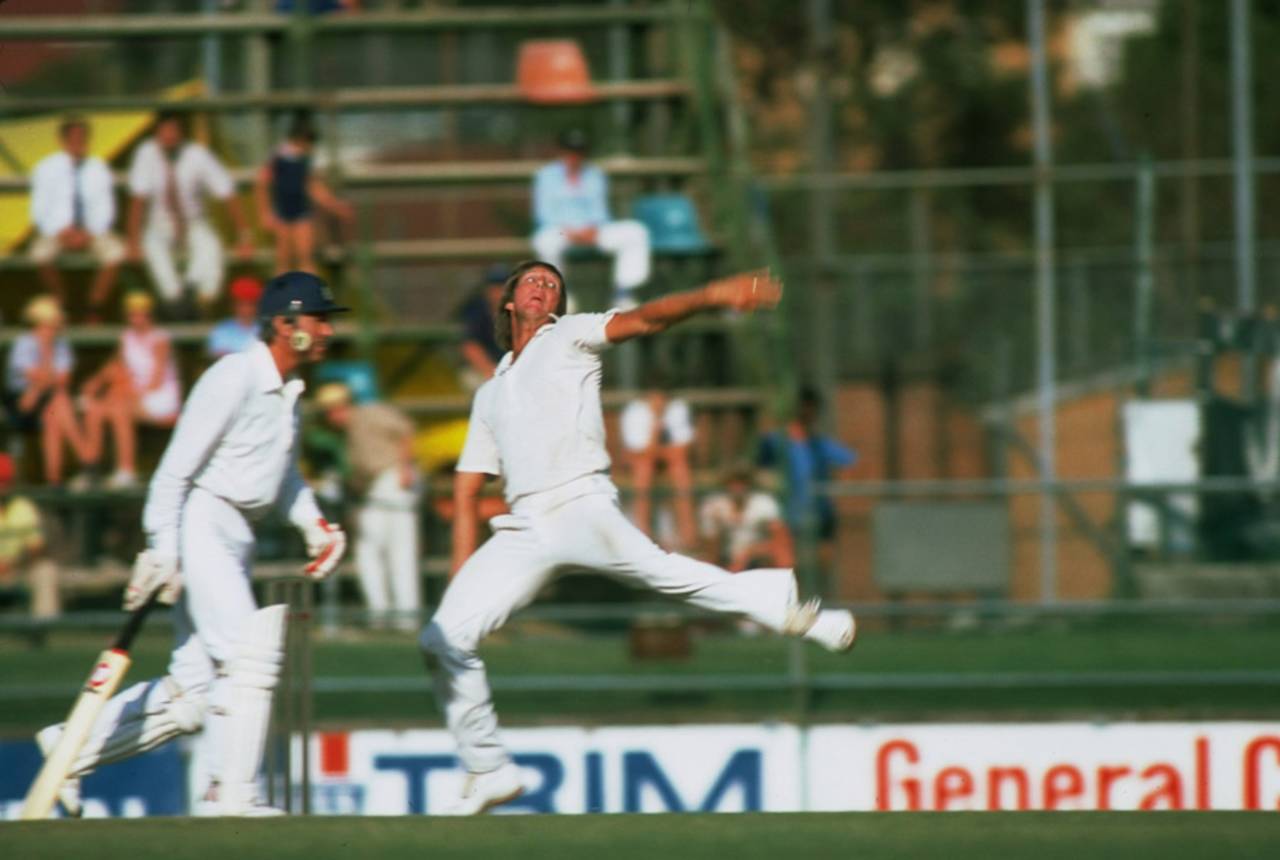"That's FAST. That's SOMETHING."
When Mark Nicholas' enthusiasm levels in the Channel 9 commentary box crank up - up, up till there's a silken hint of metal splintering off metal in the microphone he's holding - it reminds us of the romance and lingering force in cricket of words like sinister, danger, violence, fear. How is it, one suddenly notices, that in these days of heads being helmeted so many crucial joints and appendages are still not encased in a hi-tech marshmallow foam, but are exposed, and these vulnerable body parts have vulnerable-sounding names, such as ribcage, and elbow, solar plexus, neck, breastbone, and all it takes is a speeding cricket ball to bump them and then can come stinging, bruising, blood, welts, numbness, breakage? Mitchell Johnson's next ball after the Nicholas-described ball was 1.4 kilometres per hour faster:
"Up he comes again, he bowls, Trott works him on the leg side…"
Jonathan Agnew said that, on radio. This is no commentary box adventure story of the taciturn Englishman and the overexcitable Englishman. Instead it's a disjuncture: between what the eyes see and what the speed gun tells us. The ball that Nicholas saw skidded, leapt, speared into Trott's gloves, set spectators howling, and prompted Johnson to stand wide-legged and leering over the top of his moustache. The Agnew ball, technically quicker, was flicked nonchalantly behind square for three runs.
The play was
at the Gabba, England's first innings, Johnson's second spell. His third spell, from the Vulture Street End, whistled the wind through the middle order. Johnson ran in unusually straight. Balls did not bounce conventionally; they hit the ground, rose sharp, kept steepling, seemingly followed blokes. English batsman after batsman combated this with confused feet. Some jumped with the ball, a few stayed flatfooted and played with their feet far from the action, others' feet squirmed with scant enough conviction that when ball hit bat or flesh their whole bodies jerked. One delivery tore past Michael Carberry's nose - "That's a PROPER SNIFFER, that is," exclaimed Nicholas - as Carberry hooked and didn't connect and people moaned and the speed gun said only 142.6kph, and another ball missing Tremlett's off stump went unplayed at, and unremarked on, because it was not remarkable, despite coasting at 148.7.
"That HAS CANNONED into the bat stickers" - 142.3.
"OOOOH, good heat" - 141.9.
Are speed guns faulty? Probably, but a more interesting question is whether they add to or steal from our entertainment. We know, speed gun or no speed gun, that Johnson's third spell was thrilling. We know as well, thanks to the speed gun, and compared with the quick men scorching the turf in front of radars and photosonic cameras 38 summers ago, that Johnson on average has more zip than Englishmen Alan Ward and John Snow (aged 34) had and is slower than Jeff Thomson, Andy Roberts, Dennis Lillee, Michael Holding, Wayne Daniel and Bob Willis.
This is information we are entitled to, or else it's a case of too much information proving the truth to be drabber (a dozen or so kilometres drabber) than imagination, or probably it is both, which would make the speed gun a bad yet inexorable thing. Possibly it is gadgetry overload. Certainly it is addictive, and I like looking at it when the rhythm of a Test is escaping me, and I sit, watching the balls go down, watching the speedo, observing occasional rips, noticing how a bowler's readings mostly don't vary much, and then the rhythm's got me back, I forget about the speed gun, until some volcanic sweep of events has Mark Nicholas talking in capital letters again.
That is getting pseudo-psychoanalyst-like about the relationship between the speed gun and the audience. More purely, it's fun, and had furnace Adelaide Oval had a speed gun back when Larwood clattered Oldfield round the temples, all eyes would have gone first to the prostrate batsman, then to the speedo. And maybe captain Woodfull two nights earlier wouldn't have said what he said about one team's playing cricket and the other's up to something alien, would have just made a mental note to self to get a bat on those mid-140s lifters because they are never as fast as they look.
Without a speed gun, a million mythologies may flower. This is a familiar futile dilemma. A bowler's speed is now maths, batsmen's skulls are safe, hardly anyone in the world writes letters - and the speed gun, now that it is here, is no likelier to be outlawed than batting helmets or twitch-speed email. Perhaps it is close to the truth to say the speed gun makes watching cricket more entertaining, a little less enjoyable, magical. Magic lies in
imagining Jeff Thomson knock over 6 for 4 and hospitalise one other Mosman chap
at Bankstown Oval in December 1973. Were we to know mathematically and (purportedly) factually that Thommo was actually several klicks slower than Shoaib Akhtar popping one down to Nick Knight at 100mph (felt like "about 78", Knight told Mike Selvey) in Cape Town, well, that's useful information to have - but magic?
Christian Ryan is a writer based in Melbourne. He is the author of Golden Boy: Kim Hughes and the Bad Old Days of Australian Cricket and, most recently Australia: Story of a Cricket Country
